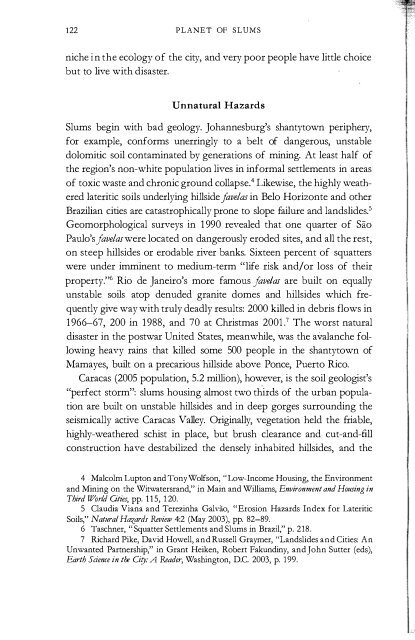Untitled - Rebel Studies Library
Untitled - Rebel Studies Library
Untitled - Rebel Studies Library
Create successful ePaper yourself
Turn your PDF publications into a flip-book with our unique Google optimized e-Paper software.
122 PLANET OF SLUMS<br />
niche in the ecology of the city, and very poor people have little choice<br />
but to live with disaster.<br />
Unnatural Hazards<br />
Slums begin with bad geology. Johannesburg's shantytown periphery,<br />
for example, conforms unerringly to a belt of dangerous, unstable<br />
dolomitic soil contaminated by generations of mining. At least half of<br />
the region's non-white population lives in informal settlements in areas<br />
of toxic waste and chronic ground collapse.4 Likewise, the highly weathered<br />
lateritic soils underlying hillside favelas in Belo Horizonte and other<br />
Brazilian cities are catastrophically prone to slope failure and landslides.s<br />
Geomorphological surveys in 1990 revealed that one quarter of Sao<br />
Paulo's favelas were located on dangerously eroded sites, and all the rest,<br />
on steep hillsides or erodable river banks. Sixteen percent of squatters<br />
were under imminent to medium-term "life risk and/or loss of their<br />
property."6 Rio de Janeiro's more famous favelas are built on equally<br />
unstable soils atop denuded granite domes and hillsides which frequently<br />
give way with truly deadly results: 2000 killed in debris flows in<br />
1966-67, 200 in 1988, and 70 at Christmas 2001.7 The worst natural<br />
disaster in the postwar United States, meanwhile, was the avalanche following<br />
heavy rains that killed some 500 people in the shantytown of<br />
Mamayes, built on a precarious hillside above Ponce, Puerto Rico.<br />
Caracas (2005 population, 5.2 million), however, is the soil geologist's<br />
"perfect storm": slums housing almost two thirds of the urban population<br />
are built on unstable hillsides and in deep gorges surrounding the<br />
seismically active Caracas Valley. Originally, vegetation held the friable,<br />
highly-weathered schist in place, but brush clearance and cut-and-fill<br />
construction have destabilized the densely inhabited hillsides, and the<br />
4 Malcolm Lupton and Tony Wolfson, "Low-Income Housing, the Environment<br />
and Mining on the Witwatersrand," in Main and Williams, Environment and Housing in<br />
Third Wo rld Cities, pp. 115, 120.<br />
5 Claudia Viana and Terezinha Galvao, "Erosion Hazards Index for Lateritic<br />
Soils," Natural Hazards Review 4:2 (May 2003), pp. 82-89.<br />
6 Taschner, "Squatter Settlements and Slums in Brazil," p. 218.<br />
7 Richard Pike, David Howell, and Russell Graymer, "Landslides and Cities: An<br />
Unwanted Partnership," in Grant Heiken, Robert Fakundiny, and John Sutter (eds),<br />
Earth Science in the City: A Reader, Washington, D.C. 2003, p. 199.<br />
SLUM ECOLOGY 123<br />
result has been a radical increase in major landslides and slope failures,<br />
from less than one per decade before 1950 to the current average of two<br />
or more per month.s Increasing soil instability, however, has failed to<br />
prevent squatters from colonizing precarious perches on the hillsides, on<br />
the slopes of alluvial fans, or in the mouths of regularly flooded canyons.<br />
In mid-December 1999, northern Venezuela, especially the El Avila<br />
massif; was clobbered by an extraordinary storm. A year's average rain<br />
fell in a few days upon already saturated soil; indeed, rainfall in some<br />
areas was reckoned to be "a once in a 1000 year" event.9 Flash floods<br />
and debris flows in Caracas - and especially along the Caribbean coast<br />
on the other side of the Avila mountains - killed an estimated 32,000<br />
people and left 140,000 homeless and another 200,000 jobless. The<br />
coastal resort of Caraballeda was devastated by the onrush of 1.8<br />
million tons of debris, including boulders as big as houses.lO A Catholic<br />
prelate implied that it was divine retribution for the recent election of<br />
the leftist government of Hugo Chavez, but foreign minister Jose<br />
Vincente Rangel responded: "It would be a harsh God who took out<br />
his vengeance on the poorest section of the community."!!<br />
What the Caracas region is to landslides, metropolitan Manila is to<br />
frequent flooding. Situated in a semi-alluvial plain bordered by three<br />
rivers and subject to torrential rains and typhoons, Manila is a natural<br />
flood basin. Mter 1898 American colonial authorities dug canals,<br />
dredged tidal channels (esteros), and built pumping stations to drain storm<br />
waters and protect the central parts of the city. Improvements in the<br />
system over recent years, however, have been counteracted by vast<br />
volumes of waste dumped into drains and esteros (the bottom of the<br />
Pasig River is supposedly a 12-foot-deep deposit of refuse );!2 subsidence<br />
due to overextraction of ground water; the deforestation of the<br />
Marikina and Montalban watersheds; and, most of all, by the ceaseless<br />
8 Virginia Jimenez-Diaz, "The Incidence and Causes of Slope Failure in the<br />
Barrios of Carracas," in Main and Williams, Em'ronment and Housing in Third World<br />
Cities, pp. 127-29.<br />
9 Gerald F. Wieczorek et aI., "Debris-Flow and Flooding Hazards Associated<br />
with the December 1999 Storm in Coastal Venezuela and Strategies for Mi_gation,"<br />
US Geological Survey, Open File Report 01-0144, \'\'ashington, D.C. 2000, p. 2.<br />
10 Pike, Howell, and Graymer, "Landslides and Cities," p. 200.<br />
11 Quoted in Richard Gott, In the Shadow of the Liberator: Hugo Chavez and the<br />
Transformation ( Venezuela, London 2001, p. 3.<br />
12 Berner, Defending a Place, p. xiv.


